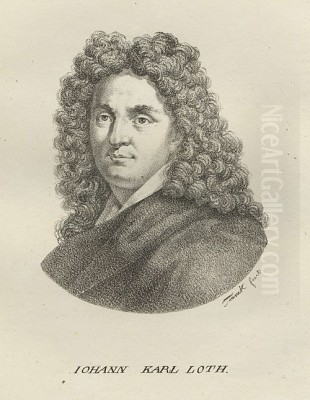
Johann Carl Loth, a significant figure in the landscape of German Baroque painting, carved a unique path by spending the majority of his prolific career not in his native land, but in the vibrant artistic crucible of Venice. Born in Munich in 1632 and passing away in Venice in 1698, Loth became so associated with his adopted city that he was often known by the Italianate nicknames "Carlotto" or "Lotti." His work, characterized by dramatic intensity and a masterful command of light and shadow, positioned him as a leading exponent of the Tenebrist style in Venice, leaving a lasting impact on both Italian and Central European art.
Early Life and Artistic Foundations
Johann Carl Loth's journey into the world of art began in his birthplace, Munich, the capital of Bavaria. He was born into an artistic family; his father was Johann Ulrich Loth, a respected painter who held a position at the court. It was under his father's guidance that the young Johann Carl received his initial training, absorbing the fundamentals of painting within the context of the South German artistic traditions of the time. This early exposure undoubtedly laid the groundwork for his technical skills.
However, the lure of Italy, the undisputed center of artistic innovation during the Baroque period, proved irresistible. Seeking to broaden his horizons and immerse himself in the latest developments, Loth traveled south. By 1653, he had made his way to Rome, a city teeming with ancient ruins, Renaissance masterpieces, and the powerful, dramatic art of recent masters that would profoundly shape his own artistic vision. This move marked a pivotal moment, transitioning him from his German apprenticeship to the heart of the Italian Baroque.
The Roman Sojourn and Defining Influences
Loth's time in Rome was crucial for his artistic maturation. He actively engaged with the city's dynamic art scene, absorbing the influences of contemporary Italian painters. Sources indicate he was particularly drawn to the works of artists like Francesco Ruschi and Pietro Liberi, painters who were themselves navigating the complex currents of Roman Baroque art. Liberi, in particular, would later become a significant contact when Loth moved to Venice.
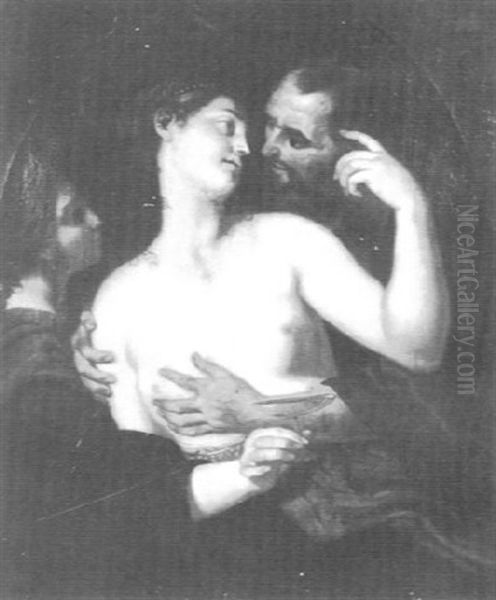
Perhaps the most decisive influence during this period, however, stemmed from the legacy of Michelangelo Merisi da Caravaggio. Though Caravaggio himself had died decades earlier, his revolutionary use of dramatic chiaroscuro – the intense contrast between light and dark – and his unvarnished naturalism continued to resonate powerfully. Loth embraced this Tenebrist approach, learning to manipulate light and shadow to create heightened emotional impact and theatricality in his compositions. This adoption of the "dark manner" became a hallmark of his style.
Establishing a Venetian Presence
Around the year 1656, Johann Carl Loth made another significant move, relocating from Rome to Venice. La Serenissima, with its own rich artistic heritage and thriving contemporary scene, would become his home and primary center of activity for the remainder of his life. He integrated himself into the Venetian artistic community, quickly gaining recognition for his powerful and distinctive style.
His arrival coincided with a period where the dramatic intensity of Tenebrism found fertile ground in Venice, partly through the work of artists like Giovanni Battista Langetti, who had also absorbed Caravaggesque lessons. Loth's German origins combined with his Roman training and Venetian surroundings created a unique artistic identity. He became a prominent figure, contributing significantly to the character of Venetian painting in the latter half of the 17th century.
The Height of a Venetian Career
In Venice, Loth's reputation flourished. He established a successful workshop and received numerous commissions, becoming one of the city's most sought-after painters. His large-scale canvases, often depicting religious or mythological narratives, were particularly favored by ecclesiastical patrons for altarpieces and by noble families seeking to adorn their palazzi with dramatic and visually arresting works.
His paintings from this period often feature complex figure groups rendered with anatomical precision and dynamic energy. While maintaining the core Tenebrist drama, his Venetian works sometimes show an evolution, incorporating the rich color traditions of the Venetian school, albeit often within a somber or dramatically lit palette. His ability to handle large, complex compositions with clarity and emotional force cemented his status. He continued to interact with fellow artists, including Pietro Liberi, who was also active in Venice.
Defining the Carlotto Style: Tenebrism and Drama
The artistic style of Johann Carl Loth is fundamentally linked to Tenebrism. His paintings are often characterized by deep, enveloping shadows from which figures emerge, dramatically illuminated by a strong, often unseen light source. This technique, derived from Caravaggio and his followers, served not merely as a stylistic device but as a powerful tool for conveying emotional intensity and focusing the viewer's attention on the core narrative or psychological state of the figures.
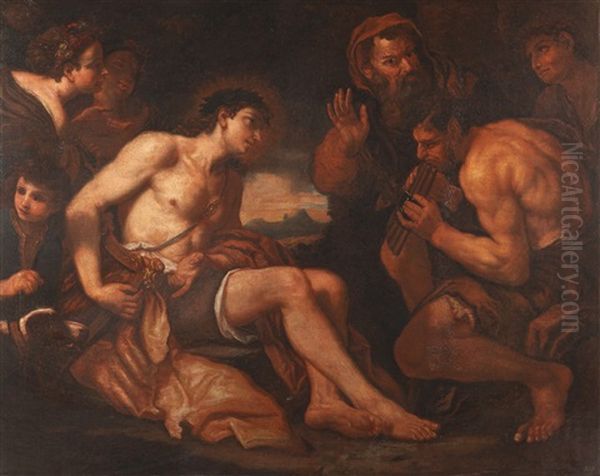
His compositions frequently feature muscular, dynamic figures caught in moments of high drama, physical exertion, or profound contemplation. Whether depicting the suffering of a martyr, the tension of a mythological encounter, or the pathos of an Old Testament scene, Loth employed chiaroscuro to heighten the scene's impact. The flesh tones are often rendered with a compelling realism, contrasting with the deep, atmospheric darkness that surrounds them. This dramatic interplay became synonymous with his name, "Carlotto."
Evolution Within the Baroque Idiom
While Tenebrism remained a constant foundation, Loth's style was not static throughout his long career. Art historians observe subtle shifts and developments. Some analyses suggest that while his earlier works might exhibit the starkest contrasts influenced by his Roman period and artists like Langetti, his later Venetian output sometimes displayed a move towards somewhat clearer compositions and perhaps a cooler, though still dramatic, color palette.
This evolution might reflect a partial assimilation of other Venetian trends or simply the natural development of a mature artist. His later works, such as those produced towards the end of the 17th century, could sometimes blend the intense drama with a degree of Baroque elegance in the figure poses and drapery. This adaptability likely contributed to his sustained success and appeal to patrons over several decades, allowing him to remain relevant within the changing tastes of the late Baroque.
Subject Matter and Thematic Range
Johann Carl Loth's oeuvre demonstrates a breadth typical of successful Baroque masters, though with a clear preference for certain themes. Religious subjects drawn from both the Old and New Testaments were a mainstay, demanded by church commissions. He painted numerous altarpieces and devotional works, often focusing on moments of martyrdom, miracles, or intense piety. Examples include The Martyrdom of Saint Gerard Sagredo and depictions of St. Joseph and the Child Jesus or The Martyrdom of St. Avellino.
Mythological themes provided another rich vein for his dramatic talents, allowing for dynamic compositions and the depiction of heroic or suffering figures. Works like Apollo and Marsyas and Jupiter and Mercury at Philemon and Baucis showcase his engagement with classical narratives. He also repeatedly explored certain Old Testament stories known for their dramatic potential, such as Lot and His Daughters (reportedly painting over 18 versions of this theme) and The Dead Abel. Furthermore, Loth undertook historical paintings and portraiture, indicating his versatility.
Masterpieces and Representative Works
Several key works stand out in Johann Carl Loth's extensive output, illustrating the different facets of his style and thematic concerns:
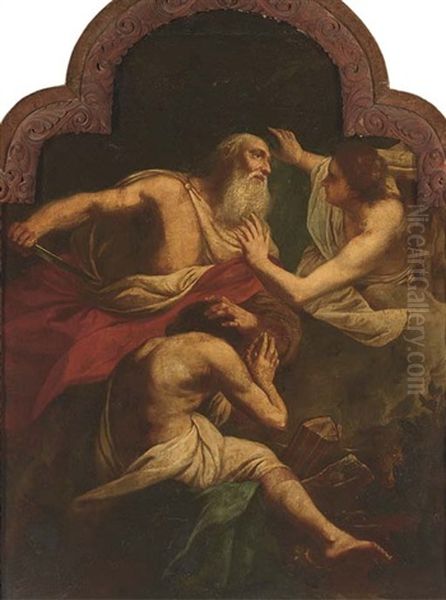
Apollo and Marsyas (c. 1684-1685): This painting exemplifies Loth's engagement with mythology and his mature handling of chiaroscuro and naturalistic detail, capturing the dramatic tension of the musical contest's aftermath.
The Martyrdom of Saint Gerard Sagredo (1677): Created as a significant altarpiece for the Basilica of Santa Giustina in Padua, this work showcases his ability to manage large-scale, multi-figure compositions filled with religious fervor and dramatic action, tailored for a major ecclesiastical setting.
The Murder of the Children of Jerusalem (or Massacre of the Innocents) (1698): Dated towards the very end of his life, this painting is cited as representing his late Venetian style, potentially showing shifts in his use of light and color while retaining the inherent drama of the subject.
Lot and His Daughters: Loth's fascination with this theme, leading him to paint numerous versions, highlights his interest in exploring complex human emotions and narratives from the Old Testament, often focusing on moments of moral ambiguity or distress.
The Dead Abel: This depiction of the aftermath of the first murder is a powerful example of Loth's ability to convey pathos and tragedy through the dramatic rendering of the human form and the stark use of light and shadow.
The Good Samaritan (17th century): A representative work illustrating a popular New Testament parable, likely showcasing his characteristic blend of realism and dramatic lighting to emphasize the scene's moral message.
Jupiter and Mercury at Philemon and Baucis: This work demonstrates his skill in interpreting classical mythology, bringing ancient stories to life with Baroque dynamism.
Other works mentioned include depictions of Pan, Apollo, The Martyrdom of St. Avellino, and St. Joseph and the Child Jesus, further illustrating his range in mythological and religious subjects. The title Govaert Flinck is also listed among his works, possibly indicating a portrait of the Dutch painter or another subject, though its context alongside mythological figures in the source material is slightly unusual.
The Workshop and Loth's Pupils
Beyond his personal output, Johann Carl Loth played a significant role as a teacher, running an active workshop in Venice that attracted aspiring artists from various parts of Europe. His influence extended considerably through his students, who absorbed his style and techniques and subsequently carried them back to their home regions or other artistic centers.
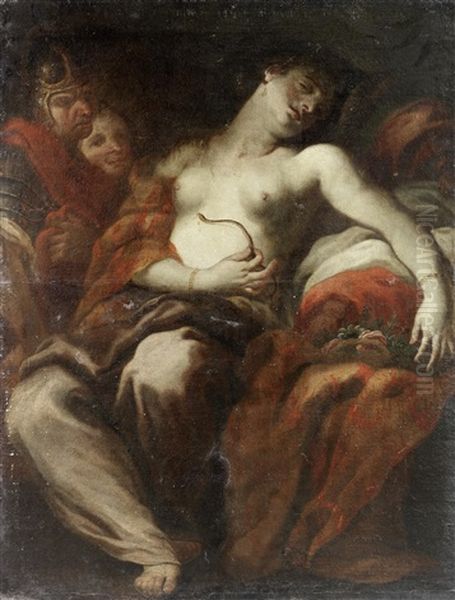
Among his notable pupils were the Dutch painter Willem Drost (who had previously been associated with Rembrandt), Cornelis de Bruijn, and the highly important Austrian painter Johann Michael Rottmayr, who became a leading figure of the High Baroque in the Habsburg lands. Other students included Paul Strudel, who also found success in Vienna, Santo Stradler (possibly Santinus Prato), Daniel Seiter (likely the "Saiter" mentioned), and Michael Wenzel Halbax (or Halbak). Through these and other pupils, Loth's dramatic Baroque style, forged in Italy, found its way into the artistic currents of Austria, Bohemia, and Southern Germany, contributing significantly to the development of Baroque painting in those regions. His circle also included friendships with artists like Jan van Bunnik.
Patronage and Esteem
Loth's success is evidenced by the high level of patronage he enjoyed. His dramatic and large-scale works were well-suited to the demands of the Counter-Reformation church and the tastes of the aristocracy. He received numerous commissions for altarpieces in Venetian churches and also worked for patrons in the Veneto region, such as the commission for Padua.
His fame extended beyond Italy. Significantly, he received commissions from the Holy Roman Emperor Leopold I, who was based in Vienna. Being employed by the Emperor, even for specific works like portraits, was a mark of considerable prestige and indicates that Loth's reputation had reached the highest levels of European society. This imperial patronage underscores his standing as one of the leading painters of his time, recognized both within his adopted city of Venice and internationally.
Final Years and Enduring Legacy
Johann Carl Loth remained active in Venice until his death in 1698. He was buried in the Church of San Luca, a testament to his integration into the fabric of Venetian society. Despite his considerable fame during his lifetime, his reputation, like that of many Baroque masters, experienced a period of decline in the subsequent centuries as artistic tastes shifted towards Rococo and Neoclassicism. For a considerable time, his work was relatively overlooked by art history.
However, the later 20th century saw a renewed scholarly interest in the Baroque period, leading to a rediscovery and reappraisal of Loth's contributions. Art historians began to study his work more closely, recognizing his technical skill, his powerful interpretation of Tenebrism, and his crucial role as a conduit between Italian and Central European Baroque painting. His influence, particularly on the development of the Baroque style in Southern Germany and Austria through students like Johann Michael Rottmayr, is now widely acknowledged.
Conclusion: A Bridge Between Worlds
Johann Carl Loth stands as a fascinating example of artistic migration and synthesis during the Baroque era. A German painter by birth and initial training, he fully embraced the artistic environment of Italy, becoming a master of a style deeply rooted in the innovations of Caravaggio. He rose to prominence in Venice, one of the most competitive art centers in Europe, developing a powerful and dramatic Tenebrist style that resonated with the religious and secular patrons of his time.
His importance extends beyond his impressive body of work. Through his active workshop, he trained a generation of artists who disseminated his style across Central Europe, making him a key figure in the international diffusion of the Italian Baroque. Though once partially obscured by the shifting tides of taste, Johann Carl Loth is now rightfully recognized as a significant painter of the 17th century, a luminary of the Venetian Baroque whose dramatic canvases continue to compel viewers with their emotional intensity and masterful execution.